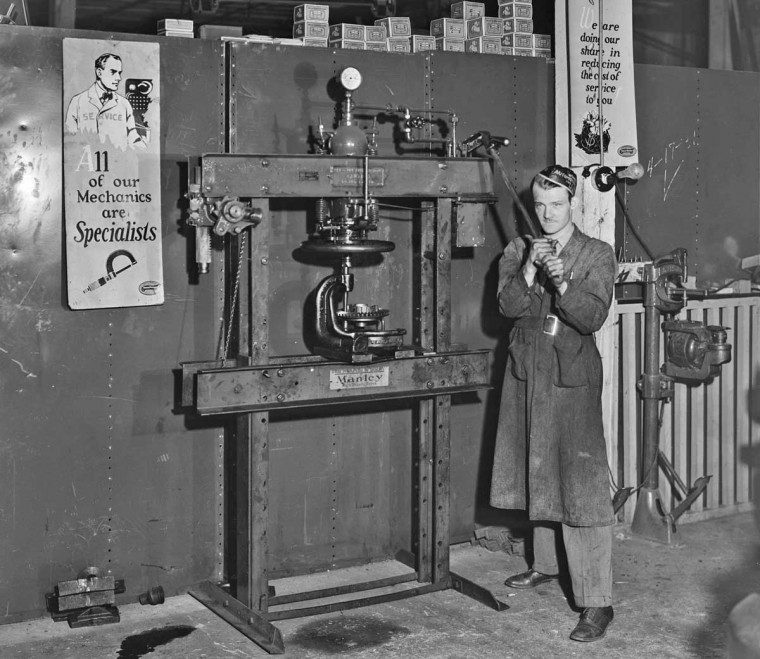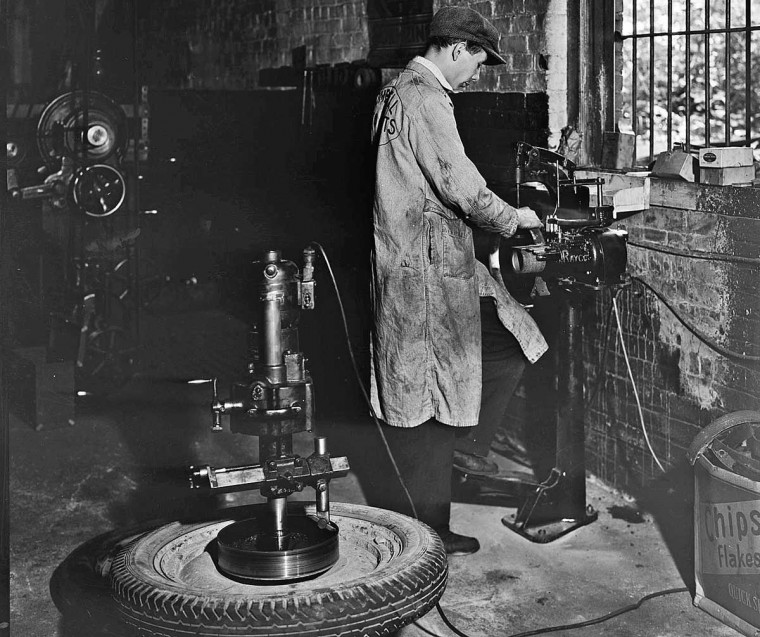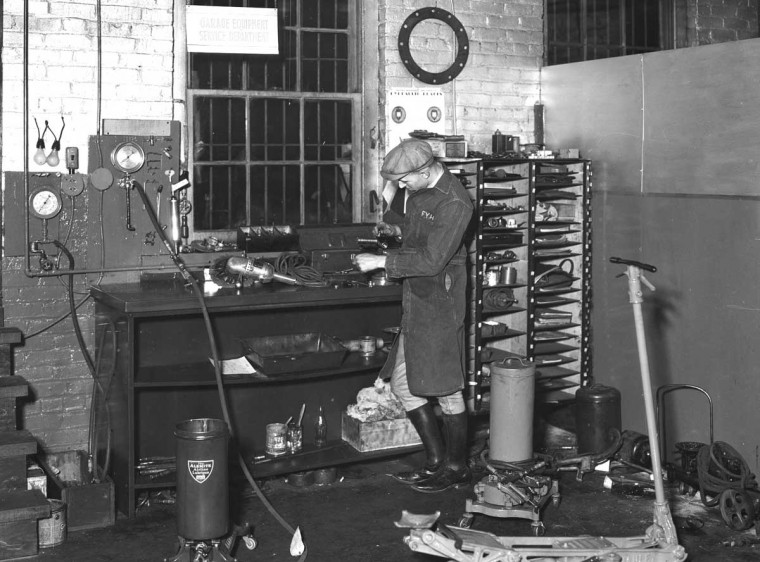A week ago we did an article about the auto machine shop and personal at Wombwell Auto Parts, located in Lexington, Kentucky. The Company also sold auto and truck parts and in many cities and towns across the US, there were similar combination parts and machining operations.
This second set of images show views of the shop taken in both 1931 and later in the mid-teens after the machinery had been relocated and repainted. You will notice signs on or above many of the machines that may have been used for an open house or for promotional photos.
The lead image dated June 1931 by the calendar on the wall shows an electric reaming machine with a gear reduction that lowered the speed to the between the motor and the three-jaw chuck used to hold the reamer. Just behind it is a rack containing all of the various sized reamers needed for connecting rod wrist pin bushings and the bores in pistons. The machinist is reaming a new Model “A” piston, and three more are on the bench next to a set of the connecting rods and the old pistons.
- This machine is a Manley combination hydraulic press with a hand-operated arbor press mounted on the left-hand side. The gig in the press is probably holding a Chevrolet differential, and was used to press out the rivets that held the ring gear onto the differential.
- Here we see a brake drum refinishing machine being used on what appears to be a Chevrolet drum.
- Wombwell’s also sold power tools and shop equipment and this was the repair department for them.
- This set of photos likely taken in 1934 showing the brake and clutch department above behind the parts store, and some of the machinery we looked at earlier plus new additions below after being repainted and reorganized.







OSHA would have a field day with this ( or any) shop during this era. I remember when every auto parts store had a machine shop, and there was always “the old man” who came out of the back ( with those greasy overalls) to answer any questions ( if he wasn’t having a bad day). Not like today, where the counter person does just that, and couldn’t tell you what to do, and the “old man” is long gone. These guys had a secure job, as every car usually needed something back then, not like today, where, just get a different car. Great photos.
Wonderful photos, much appreciated from a long-ago machinist. I confess I’m very curious about the gentleman reaming the wrist pin bushings in the top photo. If only we could see the bowl used by his wife for haircuts!
My Uncle had a repair shop in Manhattan. I loved the smells of the grease , gas , oil, mohair interiors, and rubber tires. Another time gone by.
Im trying to figure out what the machine is to the right of the guy with the hyd. press
Riveter.
Its a foot operated riveting machine for brake shoes and clutch plates.
All in one power tool for relining brakes! Done in house at a place like Wombwell’s back then. There were lots of rivets to remove and reinstall. Electric motor powers a miniature upside down drill press to drill out the old rivets, also had a drum sander for cleanup, and the foot pedal to operate the punch to set the new rivets.
Hi Chris, it looks like a brake shoe riveting machine.
Chris.. For riveting brake lining on the shoe pads. The motor arrangement below is for finishing the edges on the friction material used on the brakes. What say the experts? Me? I want to know why they need a jig saw and what is the deal with the guy sitting up high on the shelf? He reminds me of Spy vs Spy in the margins of Mad magazine.
Everybody wearing neckties. When I took machine shop way back when, our instructor used to say “In a tie with a machine, you lose.” Even so we had an idiot who insisted on wearing ties fail to tuck it into his shirt and the obvious happened with a surface grinder. Fortunately, the instructor happened to be close by and cut power before he was hurt.
And rings.
Really enjoyed this series. Regarding the last pic ; I haven’t seen a sharper in use since trade school. They are pretty a solid piece of equipment. They can also be very useful.
As a young car hobbyist growing up near Framingham, Mass, I used to buy my parts at Christie and Thompson Auto Parts. As I learned to replace brakes and clutches, and deal with blown head gaskets, I learned about the machine shop upstairs.
It was run by an older man named Ed, and looked much the same as these pictures. He worked alone up there, and it seemed his “filing system” was something no one else could ever figure out. It was always a mess up there, but Ed’s finished products always looked great.
Ed was a friendly and helpful man, and always took the time to give me a few tips on whatever job I was muddling through. When he died, the upstairs was cleaned out and that was the end of the machine shop. Like many other independent parts stores, Christie and Thompson is long gone from Framingham.
Hi Bill. There is a machinist/rebuilder out west here who is definitely Old School. He can have three engines stripped down and you cannot tell which parts go to which motor–but HE knows. To see him you’d immediately make a comparison to someone like Keith Richards; maybe 65 but looks 90, with a perpetual cigarette and a blue cloud around him all the time. I’ve known the guy for 45 years and he is a wealth of knowledge; it will be a real tragedy when he passes on because all that knowledge and skills will go into the ground with him…
I started in the “motor trade” in the UK in 1968 at a dealership (BMC) not dissimilar to these pictures. The workshop had been in existence for over 100 years at the time I started, still had all the tools for carriage repair in the rear workshop!
the pictures brought back a lot of happy memories as a 16 year old 1st year apprentice!
Picky, picky. The gizmo is the Manley press photo is a jig. A “gig” is a short-term engagement for a singer, band or comedian , etc. at a nightclub or similar venue.
Stewart, The word “gig” is commonly used in the mechanical and machining world for holding a work piece.
Many words have more than one meaning.
Wil Wing , you wondered about the bowl used for the guy’s haircut in the first photo, Looks like it’s that shape from his cap (lying on the work bench) He probably took it off for the photo..
The term: “jig” was also used in Machine Shops in Southern California, not to be confused with “jog” another Machine shop term. As to the use of “GIZMO” it is also a “trade word” from the Automobile and any other business that requires the use of driving , Tail, Stop, Spot, Steering, & Cowl LAMPS: The Glass Lens is typically held to the lamp door’s “surround” with shaped spring steel RETAINING clips, as required —called: “GIZMOES” These clips are also used to hold the sllvered parabolic reflector to the (electric) headlamp door. Yes they ARE a “Formed Spring Steel Retaining Clip” — but in most of the older Lamp Assemblies, — they are traditionally called a Gizmo, or Gizmoes . This usage APPLIES TO most “clips”. Edwin Winet .
When I was a kid I used to frequent the local MOTOR INN which was the Ford and International Harvester dealer. By the end of the forties they had given up Ford but retained IHC but being in a small town worked on everything that came through the door. There was one section of the shop that was a massive machine shop, run by one large motor and flat belt (with a loose piece of rubber that went ka-flap all day long) way up near the ceiling. Through a series of pulleys and jackshafts they ran at least ten machine tools; there was always someone using the lathe, drill press, pin-hole machine or even a grinder. In ’72 they relocated to a more modern facility at the north end of town and the old Motor Inn became a tire shop (which it still is today). The machine tools were taken down and never heard from again. How does the old saying go? Good things never last…
Does anyone know if there is a “machine shop” museum where old machines like those shown above are set up and running? Even a non-running display would still be fun to see.
Yeah.like I said,go toLargo,Florida and on the southwst corner of west bay and Seminole blvd. youll see a automotive machine shop frozen in time.Bring a flashlight its pretty dim in there.
Or theres the American Precision museum in Vermont somewheres but I think all their displays are static.
Anyone know who made the piston pin reaming machine? I have been looking for one for years. I ran one at he old Ridge Co. Machine shop in Grand Rapids, MI in my misspent youth. We used it to ream kingpins too.
I was very fortunate to work in a place very much like this in ’79..William S Archer’s Richmond Terr. Staten Island N.Y.
as did many young men waiting on “the list” for their city jobs ! I was a young niave high school grad, who partied the nights away, and went to work hung over almost daily ! But I got a priceless education by the owner himself William “pete” Archer. He was a tall lanky nasty arrogant sob, but I was told he treated me like his son ! he had me do anything an everything. looking back now, I wish I could talk to him an thank him for what he taught me as it made a big difference in my career. today very few have the experience I had, and the ability to explain why things do what they do !….iwent on to my career as a high pressure boiler operator w/Con ED N.Y.C. and now im retired in Florida and have worked for Advance Auto for 9+yrs so, believe it or not “im that old man from the back now !”…and I love it ! THANKS PETE and all the Archer Family
Hello, Does anyone have any information on the Raybestos jig saw pictured in the 1934 picture of the shop? I have one just like it, the tag says Raybestos Division Manhattan Thank You for any info